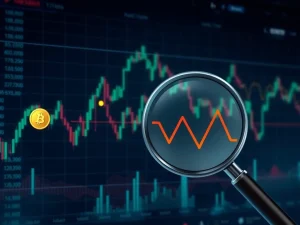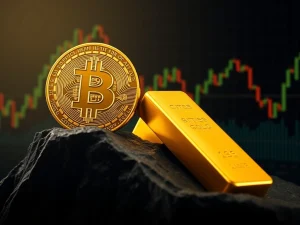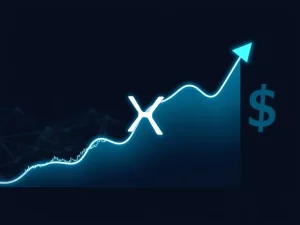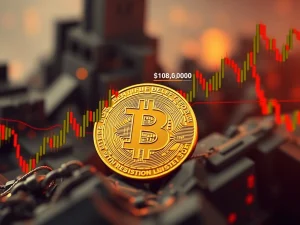Solana ETF: Will This Challenger **Dominantly** Outperform Ethereum?
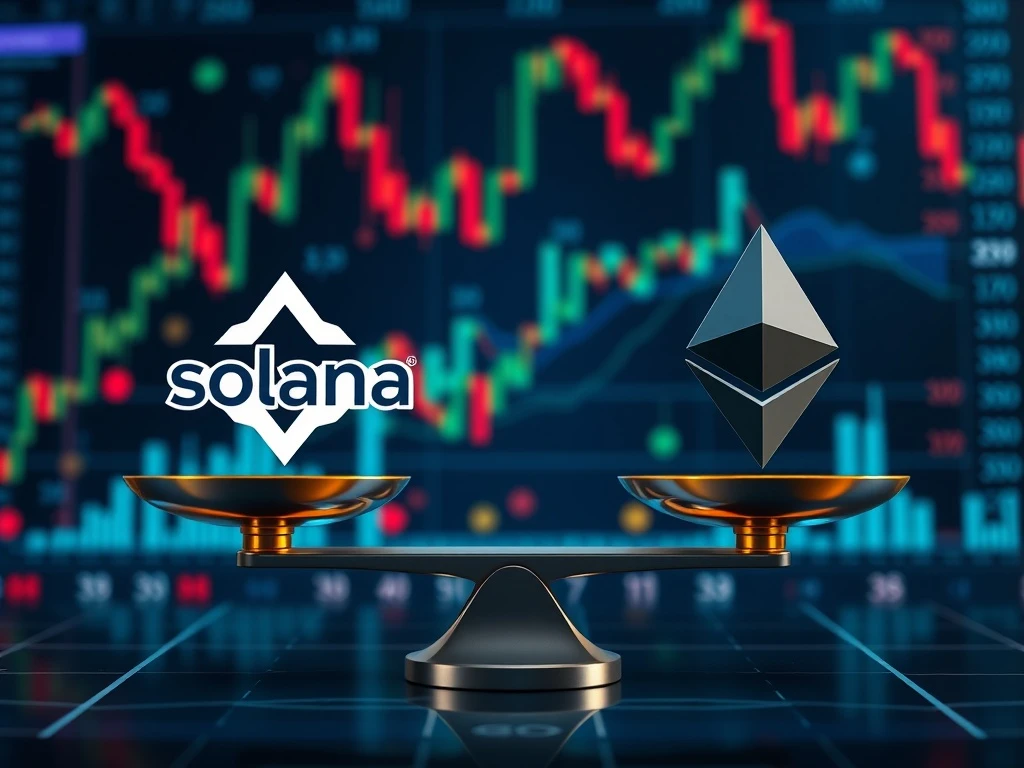
The cryptocurrency world is buzzing with a pivotal question: Can a Solana ETF truly outshine Ethereum ETF performance? With the digital asset landscape constantly evolving, the approval of a US spot Solana ETF could mark a significant turning point. Investors and analysts alike are keenly watching how new financial products might reshape market dynamics, particularly for major altcoins like Solana (SOL) and Ethereum (ETH). This comprehensive analysis delves into the potential shifts in access, investment flows, and network usage, offering key metrics to monitor if Solana indeed begins to outperform Ethereum.
The Race for Crypto ETFs: Solana vs. Ethereum
The competition in the crypto ETFs space is intensifying. Ethereum (ETH) already holds a significant head start in the exchange-traded fund (ETF) race. Spot Ether ETFs began trading in the US on July 23, 2024. They attracted approximately $107 million in first-day net inflows. This opened a mainstream path for investors through traditional brokers and retirement accounts. However, Solana’s (SOL) market infrastructure is rapidly catching up. The Chicago Mercantile Exchange (CME) launched Solana futures on March 17, 2025. Furthermore, options are slated for October 13, pending approval. In September 2025, the US Securities and Exchange Commission (SEC) adopted “generic listing standards.” These standards streamline how exchanges can list spot commodity exchange-traded products (ETPs). This development potentially widens the gate beyond just Bitcoin (BTC) and Ether. Additionally, outside the US, SOL already trades in regulated investment wrappers. Europe’s 21Shares and Canada’s 3iQ offer these products. With this existing access, the central question emerges: Can a US SOL ETF fuel lasting demand, allowing Solana to outperform Ether on both price and fundamental metrics? We will explore this question by first setting the context of what ETH ETFs changed, and what they did not.
Ethereum ETF: Early Impact and Cyclical Flows
The introduction of Ethereum ETF products significantly altered market access. Spot Ether ETFs began trading in the US on July 23, 2024. On their first day, they recorded about $1 billion in trading volume and roughly $107 million in net inflows. This development created a mainstream channel for various investors. These include registered investment advisers (RIAs) and larger institutions. However, this initial scale still trailed Bitcoin’s ETF debut in January. Flows since then have shown cyclical patterns. Through mid-2025, ETH experienced periods of net creations, punctuated by outflows. By late August and mid-September 2025, reports indicated renewed strength. Multi-week inflows into Ether products lifted total crypto assets under management (AUM). In short, ETFs improved access, but they did not eliminate market cycles. At times in 2025, Ether outperformed many large-cap crypto assets. Steady ETF demand and visible institutional accumulation supported this. This pattern suggests that while ETFs do not alter core network fundamentals, they can influence which asset leads during phases of capital rotation. One design choice still matters significantly: US ETH ETFs launched without staking. This limits their income potential compared with holding native ETH directly. The SEC is actively reviewing proposals to allow staking. Yet, as of October 2025, it has delayed decisions across multiple issuers. If staking is permitted—even partially—it could shift the trade-offs between ETF holdings and direct ownership. Investors should note that US exchanges publish an indicative net asset value (iNAV) approximately every 15 seconds. This allows traders to see where an ETF should be priced intraday.
Solana’s Ascendance: Usage and Growth Drivers
Solana continues to demonstrate robust growth and significant network usage. In Q2 2025, Solana generated over $271 million in network revenue. This marked its third consecutive quarter leading all layer-1 (L1) and layer-2 (L2) chains. In June, data showed Solana matched the combined monthly active addresses of all other major L1s and L2s. These are strong indicators of usage intensity. In January 2025, Solana processed $59.2 billion in peer-to-peer (P2P) stablecoin transfers. This represented a sharp rebound from the lows of late 2024. The supply of USDC on Solana stands at approximately $9.35 billion. Furthermore, the network’s total stablecoin supply more than doubled in early 2025. It climbed from $5.2 billion in January to $11.7 billion in February. Even so, Ethereum still carried the majority of value moved by stablecoins year-to-date—roughly 60% as of mid-2025. This shows Solana’s gains are meaningful but not yet dominant. Cost and speed remain key draws for Solana. Sub-cent fees, 400-millisecond block times, and high throughput have made Solana a hub for decentralized exchange (DEX) and perpetual futures activity. It became a focal point of 2025’s memecoin boom. That volume supports liquidity but also concentrates flows in speculative segments. However, two structural risks are worth watching. First, reliability: A five-hour outage on February 6, 2024, required a coordinated restart and client patch (v1.17.20). Second, regulation: Past US SEC complaints have referenced Solana as an unregistered security. The Solana Foundation disputes this characterization. Outcomes in this area remain highly policy-dependent. The CME plans daily, monthly, and quarterly expiries for SOL options. This will expand hedging menus for ETF market makers.
Unlocking New Avenues: The Potential of a US Solana ETF
The approval of a US Solana ETF would likely trigger several significant changes in the cryptocurrency market. Firstly, it would vastly expand access and flows. Approval would open SOL to mainstream brokerage and retirement channels, commonly used by registered investment advisers (RIAs). This reduces operational friction for allocators and broadens the buyer base beyond crypto-native venues. Secondly, it would enhance market-making and hedging capabilities. Listed derivatives give authorized participants (APs) and market makers the essential tools to hedge creations and redemptions. They can also run basis or relative-value trades. These mechanics help keep ETF prices close to their Net Asset Value (NAV) and support day-one liquidity. Thirdly, the regulatory runway appears more favorable. The SEC’s “generic listing standards” widen the path beyond Bitcoin and Ether if sponsors satisfy the established rules. Lastly, ex-US demand signals are already strong. Canada’s 3iQ Solana Staking ETF (TSX: SOLQ) and Europe’s 21Shares Solana Staking ETP (SIX: ASOL) demonstrate that regulated investment wrappers for Solana can attract significant investor interest. It is important to remember that in Europe, cryptocurrencies cannot be included in Undertakings for Collective Investment in Transferable Securities (UCITS) ETFs. Therefore, issuers use ETPs instead, which explains why “ETP” appears on SIX and London Stock Exchange (LSE) tickers.
Can Solana Outperform Ethereum? Analyzing Key Metrics
The central question remains: Can Solana outperform Ethereum? The answer depends on several factors, presenting various scenarios for the market. Here’s a breakdown of potential outcomes:
The Bull Case (Six to 12 Months Post-Approval)
- Broader Access: A timely US spot SOL ETF with strong early net creations could potentially outpace Ether on total return. RIAs and brokerages would gain exposure under the new generic listing standards, bringing in fresh capital.
- Improved Market Mechanics: Tighter spreads and greater capacity would emerge as APs hedge via CME Solana futures and listed options. This increased liquidity and efficiency could drive stronger price performance.
The Base Case
Even if a SOL ETF launches strongly, flows may revert to tracking general risk appetite. Ether retains a structural institutional edge. This is thanks to its longer history, deeper allocator familiarity, and established ecosystem. Weekly fund flow fluctuations in crypto reflect how relative performance may be choppy rather than decisively tilted toward SOL. This scenario suggests that while Solana might see initial surges, sustaining outperformance against Ethereum would be a challenge without consistent, differentiated catalysts.
The Bear Case
Timelines slipping or eligibility questions under the US SEC framework could dampen expectations for a Solana ETF. Alternatively, liquidity may soften, and APs could run smaller books despite the availability of derivatives, limiting creations. In that scenario, Solana would underperform Ether, which already benefits from a more mature distribution. It is also worth noting that some regulators have expressed concerns about reduced case-by-case scrutiny under the generic listing standards. This adds policy uncertainty for assets beyond Bitcoin and Ether. This regulatory caution could hinder Solana’s progress.
Key Metrics to Watch for SOL vs ETH
If a US spot Solana ETF is approved, the real story will unfold in the subsequent market activity. The key signals to watch are straightforward and data-driven. First, do creations and redemptions show persistent demand? Sustained inflows into the ETF indicate genuine investor interest. Second, does CME open interest and options activity deepen liquidity? Increased derivative activity suggests robust market maker engagement and hedging capabilities. Third, do on-chain metrics like active users, fee revenue, stablecoin settlement, and developer growth hold up beyond speculative bursts? Real, organic network usage is crucial for long-term value. If those needles move together, the odds of SOL outpacing ETH rise sharply. A Solana ETF would remove a major access bottleneck and arrive with stronger market infrastructure than past cycles. Yet Ether has already proven it can attract billions through ETFs while anchoring the institutional conversation. ETH remains the benchmark, and its flows—though cyclical—demonstrate its staying power. Whether Solana truly outperforms will depend less on hype and more on whether ETF inflows translate into sustained on-chain adoption and fundamental growth. This article does not contain investment advice or recommendations. Every investment and trading move involves risk, and readers should conduct their own research when making a decision.



